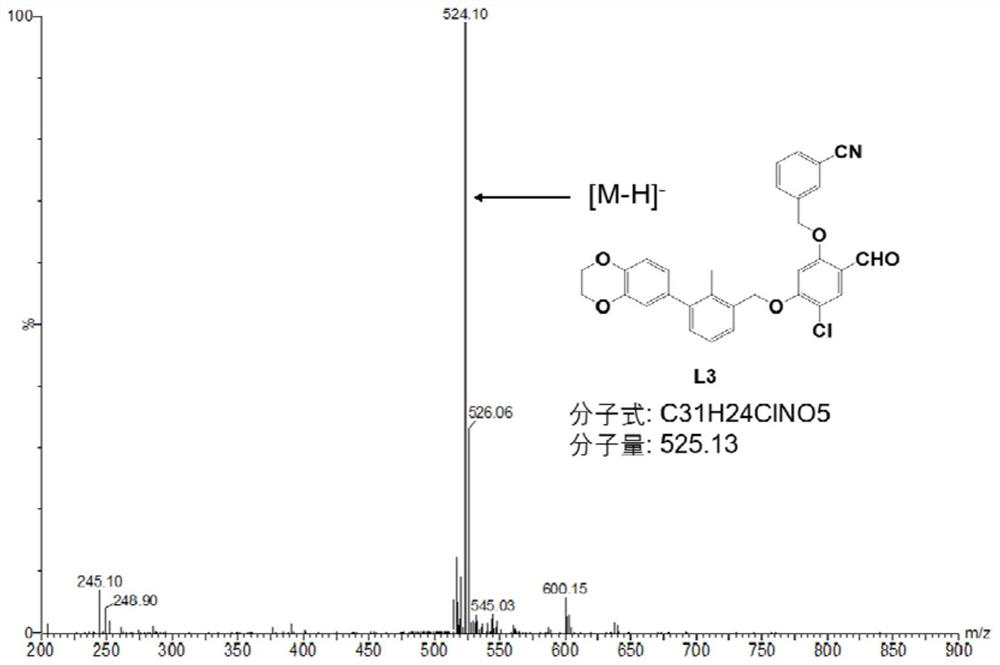Programmed cell death protein receptor-1 targeted molecular probe and preparation
A technology of cell death and molecular probes, applied in preparations for in vivo experiments, radioactive carriers, in vivo radioactive preparations, etc., can solve the problem of difficult to predict the targeting effect of PD-L1, few researches and reports on small molecule probes, Problems such as compound structure changes, to achieve good radioactivity specific activity, low cost, and easy synthesis
- Summary
- Abstract
- Description
- Claims
- Application Information
AI Technical Summary
Problems solved by technology
Method used
Image
Examples
Embodiment 1
[0066] Example 1 Synthesis of the PET probe precursor LN targeted by programmed cell death protein receptor-1
[0067] The PET probe precursor LN has a structure shown in the following formula:
[0068]
[0069] The synthetic route map of described PET probe precursor LN is as follows:
[0070]
[0071] The preparation method is as follows:
[0072] (1) Synthesis of Compound L1
[0073] First, a total of 200 ml of solvent (1,4-dioxane: pure water = 4:1, v / v) was blown through nitrogen to remove oxygen in the mixed solvent. Take benzo-1,4-dioxane-6-boronic acid (1.8g, 0.01mol), 3-bromo-2-methylbenzyl alcohol (2.0g, 0.01mol), anhydrous potassium carbonate (13.0g, 0.09mol) into a reaction flask, put a magnetic stirrer, and then add tetrakis(triphenylphosphine)palladium (1.0g, 0.80mmol). Insert a drying condenser into the reaction bottle, inject the solvent, heat at 100°C under the protection of nitrogen, reflux the condensed water, and react for 24 hours. After the rea...
Embodiment 2
[0094] Example 2 Programmed cell death protein receptor-1 targeted PET probe [ 18 F] Synthesis of LN
[0095] The PET probe [ 18 F]LN has the structure shown in the following formula:
[0096]
[0097] The PET probe [ 18 F]LN's marked route is as follows:
[0098]
[0099] The specific marking method is as follows:
[0100] (1) Before marking:
[0101] a. Sep-Pak light QMA column activation: draw 10mL of 0.5M sodium bicarbonate (NaHCO 3 ) solution, slowly pour it into the column for cleaning, then draw 10mL of sterile water for injection for cleaning, and finally suck air into the syringe to dry the QMA column. After activation, the QMA column is hung up and ready to be passed to the target.
[0102] b. Sep-Pak light C18 column activation: first take 10mL of ethanol and slowly inject the C18 column, and then wash it with 10mL sterile water for injection.
[0103] c. Preparation of labeling precursor: 10 mg of compound LN was dissolved in 465 μL of DMF to prepare ...
experiment example 1
[0107] Experimental example 1 in vitro stability study
[0108] After purification the probe [ 18 F] LN was incubated with PBS buffer (pH=7.4) or mouse serum for different times to evaluate, specifically: 50 μL probe [ 18 F] LN (37MBq) were mixed with 450 μL PBS or mouse serum solution, and then placed at 37°C for different time (1, 2, 4 hours). Among them, serum stability is at each detection time point, take about 20 μ L of the mixed solution and add an equal volume of acetonitrile to precipitate and centrifuge to remove protein impurities, and take the supernatant for radioactive HPLC analysis.
[0109] The result is as Figure 13 As shown, [ 18 F] LN was incubated with mouse serum or PBS at 37°C for 1 to 4 hours, showing a single peak in the HPLC spectrum, and also obtained good stability.
PUM
 Login to View More
Login to View More Abstract
Description
Claims
Application Information
 Login to View More
Login to View More - R&D
- Intellectual Property
- Life Sciences
- Materials
- Tech Scout
- Unparalleled Data Quality
- Higher Quality Content
- 60% Fewer Hallucinations
Browse by: Latest US Patents, China's latest patents, Technical Efficacy Thesaurus, Application Domain, Technology Topic, Popular Technical Reports.
© 2025 PatSnap. All rights reserved.Legal|Privacy policy|Modern Slavery Act Transparency Statement|Sitemap|About US| Contact US: help@patsnap.com



